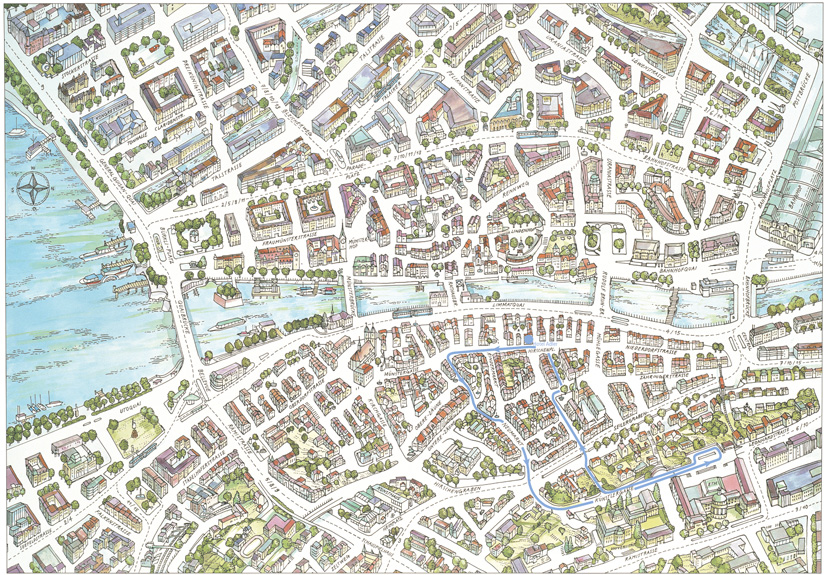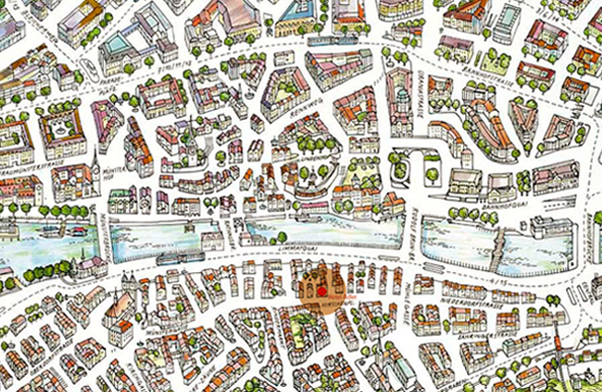Tour 1
Hirschenplatz – Niederdorfstrasse – Stüssihofstatt – Münstergasse (bis Confiserie Schober) – Napfgasse – Spiegelgasse – Neumarkt – Hirschengraben/ Seilergraben – Künstlergasse – Universität – Eidgenössische Technische Hochschule – Sempersteig – Predigerplatz – Spitalgasse – Hirschenplatz
Map City Tour 1
Details: Tour 1

The Prediger district
The Spitalgasse originally constituted the main access to the Prediger district. The name Spitalgasse (hospital lane) is a reminder of the district’s once central function. After the dissolution of the Prediger monastery during the Reformation, the district developed into Zurich’s hospital quarter. Various main and auxiliary hospital buildings were situated between Central, a busy junction, and the Prediger church. There were also extensive gardens and graveyards, which served both the church and the hospital.
The history of hospitals in Zurich reveals medical and hygienic conditions that are now difficult to accept. A singe illustration must here suffice. In 1800, the physically and mentally ill still shared the same wards within the walls of the old monastery. It was not until the 19th century that enlightened medical and social thinking brought about change and led in 1842 to the opening of a new hospital, situated on the grounds of today’s University Hospital on Rämistrasse. The old Spitalgasse also originally led to the so called “Mushafen,“ a small place where the poor and the sick of the town were provided with free meals.
Of the Prediger monastery itself, only the parish church and the impressive, High Gothic choir remain. The monastery, which had later served as a hospital, fell victim to a fire in 1887. Since 1917, the Zentralbibliothek, Zurich’s main public library, has stood in its place. The tall and elegant Neo Gothic tower of the Prediger church, designed by the architect Gustav Gull (1858–1942), was built between 1898 and 1900.
The Stüssihofstatt

It is the Stüssi fountain in particular that gives the square its special character. Admittedly, Zurich’s Old Town has numerous beautiful fountains. But in contrast to Berne, Switzerland’s capital, the local population of Zurich is not as aware of the many fountains in their town, nor do visitors always notice them, perhaps because they are distributed over a rather large area. Built in 1574 during the Renaissance, an era when art was much appreciated, the Stüssi fountain constitutes a particularly beautiful example among Zurich’s many fountains. It dominates the irregularly shaped Stüssihofstatt, which slopes down towards the river Limmat. The basin of the fountain was renovated in 1767. In 1919, the fountain’s figure, like most of the others in the Old Town, was replaced with a replica.

The Napfplatz


The Neumarkt

Directly behind the “Kantorei“ with its Neoclassical facade stands the prominent Grimmenturm (Spiegelgasse no. 29). During renovations in the 19th century, the upper part of the Grimmenturm’s roof and the small bell tower were removed. About 100 years later, in 1964, an organisation for the preservation of historic monuments rebuilt the upper part of the roof and the small tower in order to correct these ill considered modifications, which had considerably altered the look of the Old Town. The name of the Early Gothic residential tower comes from Johannes Bilgeri, who was called the “Grimme“ (the furious). According to sources, Bilgeri bequeathed in 1350 the residential tower as well as the adjoining “Haus zum langen Keller“ (Rindermarkt no. 26) to the needy of the Prediger hospital and to the Beguine Sisterhood. An impressive series of Early Gothic paintings dating from around 1300, which, in the past, used to be shown in the “Haus zum langen Keller“, can now be admired in the Swiss National Museum. These valuable paintings depict, among other things, the German king of the time and his Electors as well as interesting scenes from the life of knights.

The house is open to the general public and even its inner courtyard is well worth a visit. The contemporary appearance of the house is the result of the several enlargements and alterations that have taken place over more than a thousand years.
As a consequence of these changes, the house clearly shows the influence of different time periods and thus illustrates history in a very graphic way. The surviving paintings on the facade, for example, testify to the fashion of the 16th century. The decorative work also conveys the manner of artistic expression of Zurich’s prosperous families. The ceiling of the stairwell shows paintings dating back to the 17th century. Similar paintings, of every conceivable colour composition, can be found in other rooms of the house and give an impression of housing tradition at that time. The richly decorated railings and banisters, dating back to the 18th century, testimony to the former craft of blacksmiths.


The University district

Zurich cannot be considered an “old university town,“ despite the fact that the town’s scholarly traditions date back to the Middle Ages when theology, above all other subjects, was studied at the “Carolinum,“ the Grossmünster’s educational institution. The interest in education arising in the 1830s led to cantonal legislation regulating education from the elementary to the university level in an innovative and thorough manner. The University, founded in 1833, was first housed in the “Hinteramt“ situated on Fröschengraben, but this later fell victim to the construction of the Bahnhofstrasse.
As from 1864, the University was situated in the so-called “Universitätsflügel“ (university wing) of the Federal Institute of Technology (ETH). The ETH, designed by Gottfried Semper (1803–1879), was opened in 1855. The German theologian David Friedrich Strauss (1808–1874) made the following political comment about the location of the ETH: “Although I am a convinced monarchist, I have to admit that only a republic could think to build a palace for higher education in such a special location. If Switzerland was a monarchy, the place would rather be used for a prince’s palace or military barracks.“
The fact that the University and more especially the Federal Institute of Technology rapidly gained such an excellent reputation in Europe and beyond was mainly due to the large number of political refugees from Germany. Expelled from their homeland, many professors found both a place of work and an eager student audience in the democratic Swiss Republic and most particularly in Zurich. 
Reviews
Barry S
Google, 19.8.23
Very nice boutique Hotel. Convent to the main station and tram 4 . Maybe a ten minute walk . ( we walked upon arrival ) In a nice area of old town with many shops and restaurants steps away . Easy check in . They have complimentary water and drinks . Museum access that we took advantage of . Our room was on the top floor with a balcony . Would not consider staying anywhere else .
Sarah B
TripAdvisor, 19.8.2023
Nice location, even better people!
Anne Clarisse V
Google, 5.9.2023
Spent my birthday here and it was lovely. The fondue and raclette tasted amazing! And the staff was very friendly. They also sang happy birthday and brought out an ice cream dessert with a sparkler.
David S
TripAdvisor, 2.9.2023
Cheese fondue heaven.
Our Location
Hotel Adler Zürich
Rosengasse 10
CH-8001 Zurich
+41 44 266 96 96
info@hotel-adler.ch
Our front desk is available 24/7
Reviews
Our Partners
© Hotel Adler Zürich | Imprint | Terms & Conditions | Privacy | Voucher | Covid-19











